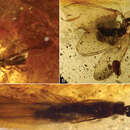Description
provided by Zookeys
Imago: Total length without wings (as preserved) 4.9 mm; forewing length 6.0 mm; pronotal length (medial) 0.75 mm, width 1.20 mm; length of forewing scale 0.80 mm. Integument of head dark brown, nearly black, except antenna and mouthparts brown; pronotum and remainder of thorax dark reddish brown, legs brown; abdomen dark brown. Integument apparently finely imbricate (where evident). Head relatively large (although left side and much of vertex distorted by compression), length greater than width, lateral borders slightly convex and parallel, with scattered, erect, stout setae, such setae sparse on lateral surface behind compound eye. Compound eyes relatively small, circular, weakly exophthalmic, positioned well anterior on head, separated from posterior border of head by more than compound eye diameter. Fontanelle present, circular, located midway along tangent between middle of compound eyes. Ocelli small, semicircular, positioned anterodorsal to compound eye, separated from compound 2.5–3.0x ocellar diameter. Antenna moniliform, number of articles indeterminate owing to preservation, visible articles with moderately numerous, minute, apically-directed setae and microtrichia. Pronotum slightly wider than long, slightly broader than head, anterior margins slightly conergent mediad, apicolateral corners acutely rounded, lateral margins initially parallel in apical quarter then slightly tapering posteriorly with broadly-rounded posterior corners, medial posterior margin relatively straight; surface with numerous stout, short, suberect, posteriorly-directed setae except those along anterior margins slightly more dense and directed anteriad. Legs with numerous short to moderate-length setae; tibiae without distinct spines; tibial spur formula 2-2-2; tarsi tetramerous; pretarsal ungues simple; arolium absent. Forewing scale large, slightly overlapping hind wing scale; hind wing scale smaller than forewing scale; both fore and hind wing scales covered with numerous, stout, short, erect to suberect setae, such setae intermingled with longer setae, particularly apically along veins; hind wing with C+Sc+R and Rs thick, sclerotized, with ~5 short, perpendicular crossveins connecting them in apical third; M bifurcate in apical half, originating from CuA outside of wing scale; Cu with at least five main branches, two branches with short bifurcate branches at apex; apex of Cu reaches to 0.92x length of wing; no reticulate crossveins present; membrane very finely and densely pimplate. Abdomen apparently with scattered setae similar to those on wing scales.
- license
- cc-by-3.0
- copyright
- Michael S. Engel, David A. Grimaldi, Paul C. Nascimbene, Hukam Singh
- bibliographic citation
- Engel M, Grimaldi D, Nascimbene P, Singh H (2011) The termites of Early Eocene Cambay amber, with the earliest record of the Termitidae (Isoptera) ZooKeys 148: 105–123
- author
- Michael S. Engel
- author
- David A. Grimaldi
- author
- Paul C. Nascimbene
- author
- Hukam Singh

